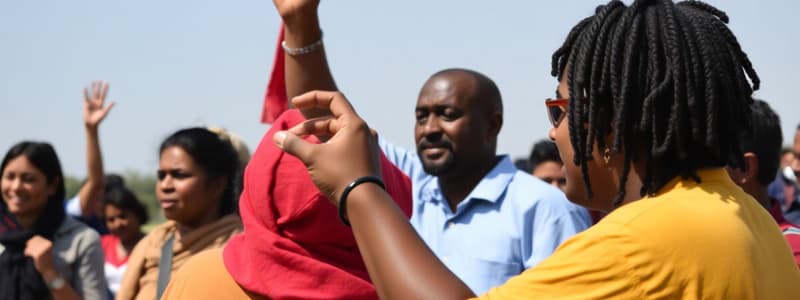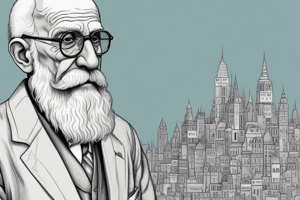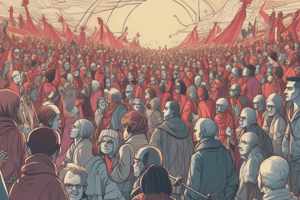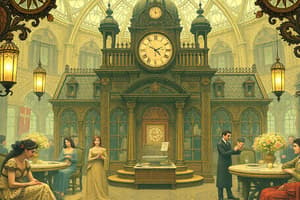Podcast
Questions and Answers
Match the following types of societies with their primary means of sustenance:
Match the following types of societies with their primary means of sustenance:
Hunter-Gatherer = Reliance on naturally occurring vegetation and animals Horticultural = Domestication of plants with basic tools Agricultural = Raising crops using advanced technology like plows and irrigation Industrial = Mechanized production and division of labor based on expertise
Match the following types of solidarity with their description:
Match the following types of solidarity with their description:
Mechanical Solidarity = Social cohesion based on the similarity of individuals in a group. Organic Solidarity = Social cohesion based on the interdependence of specialized roles. Social Cohesion = The degree to which people are bound together in a society. Integration = The process of incorporating individuals into a group or society.
Match the following concepts with their definitions:
Match the following concepts with their definitions:
Ethnocentrism = The tendency to view one's own group and its cultural expectations as right, proper, and superior to others. Cultural Relativism = Setting aside one's own cultural beliefs to understand a group through the eyes of its members. Norms = Rules of behavior shared by members of society. Values = Shared judgments about what is desirable or undesirable, right or wrong.
Match the following components of culture with their examples:
Match the following components of culture with their examples:
Match the following types of cultures with their descriptions:
Match the following types of cultures with their descriptions:
Match the following terms related to societal norms with their corresponding descriptions.
Match the following terms related to societal norms with their corresponding descriptions.
Match the historical period with the societal change that defines it:
Match the historical period with the societal change that defines it:
Match the following theoretical perspectives with their focus on culture:
Match the following theoretical perspectives with their focus on culture:
Match the following concepts with their descriptions related to how societies are held together:
Match the following concepts with their descriptions related to how societies are held together:
Match the following values to the descriptions:
Match the following values to the descriptions:
Match the society type to the description of food production strategies
Match the society type to the description of food production strategies
Match each concept with its corresponding description regarding cultural understanding.
Match each concept with its corresponding description regarding cultural understanding.
Match each type of norm with its corresponding consequences for violation.
Match each type of norm with its corresponding consequences for violation.
Match the following historical period with its defining characteristic.
Match the following historical period with its defining characteristic.
Match the type of sanction to its description.
Match the type of sanction to its description.
Match the following cultures with their respective descriptions:
Match the following cultures with their respective descriptions:
Match each evolutionary stage of society with its key technological development or advancement.
Match each evolutionary stage of society with its key technological development or advancement.
Match the theorists with the theory or concept that they are best known.
Match the theorists with the theory or concept that they are best known.
Match the following aspects of culture with their characteristic.
Match the following aspects of culture with their characteristic.
Match the following theoretical perspectives with how each would analyze cultural phenomena.
Match the following theoretical perspectives with how each would analyze cultural phenomena.
Match each type of nonmaterial culture with its expression.
Match each type of nonmaterial culture with its expression.
Match the following elements tied to premodern/early societies with their properties
Match the following elements tied to premodern/early societies with their properties
Match the following types of subcultures with their characteristics:
Match the following types of subcultures with their characteristics:
Match the following terms regarding cultural change with their definition
Match the following terms regarding cultural change with their definition
Match the following with an accurate description:
Match the following with an accurate description:
Flashcards
Culture
Culture
The way of life shared by a group of people, including knowledge, beliefs, values, rules or laws, language, customs, symbols, and material products.
Society
Society
An organized and interdependent group of individuals living in a specific geographical area, interacting, cooperating, and sharing a common culture.
Mechanical Solidarity
Mechanical Solidarity
Social cohesion and integration based on the similarity of individuals in the group (beliefs, values, etc.)
Organic Solidarity
Organic Solidarity
Signup and view all the flashcards
Hunter-Gatherer Societies
Hunter-Gatherer Societies
Signup and view all the flashcards
Herding Societies
Herding Societies
Signup and view all the flashcards
Horticultural Societies
Horticultural Societies
Signup and view all the flashcards
Agricultural Societies
Agricultural Societies
Signup and view all the flashcards
Industrial Societies
Industrial Societies
Signup and view all the flashcards
Postindustrial Societies
Postindustrial Societies
Signup and view all the flashcards
Culture (Definition)
Culture (Definition)
Signup and view all the flashcards
Ethnocentric Views
Ethnocentric Views
Signup and view all the flashcards
Cultural Relativism
Cultural Relativism
Signup and view all the flashcards
Material Culture
Material Culture
Signup and view all the flashcards
Nonmaterial Culture
Nonmaterial Culture
Signup and view all the flashcards
Values
Values
Signup and view all the flashcards
Norms
Norms
Signup and view all the flashcards
Folkways
Folkways
Signup and view all the flashcards
Mores
Mores
Signup and view all the flashcards
Taboo
Taboo
Signup and view all the flashcards
Laws
Laws
Signup and view all the flashcards
Sanctions
Sanctions
Signup and view all the flashcards
Microculture
Microculture
Signup and view all the flashcards
Subculture
Subculture
Signup and view all the flashcards
Counterculture
Counterculture
Signup and view all the flashcards
Study Notes
Culture and Society Overview
- Culture is the way of life shared by a group, encompassing knowledge, beliefs, values, rules, language, and material products.
- Culture provides the framework for everything within a society.
- Society is an organized, interdependent group living in a specific area, interacting more with each other than outsiders.
- Societies cooperate for shared goals and share a common culture over time.
- Society provides the structure learned through culture.
Social Solidarity
- Early traditional societies have "mechanical solidarity," according to Durkheim.
- Mechanical solidarity is social cohesion based on the similarity of beliefs and values within the group.
- Simple division of labor is based on gender and age.
- In more modern societies, solidarity is more "organic".
- Organic solidarity is based on a division of labor where members have specialized, interdependent tasks.
- Modern societies feature less social consensus and shared values, but necessity of dependence holds people together.
- Larger organizations and institutions have shifted society toward the macro level.
Societal Development
- Lenski theorized that technology is a driving force in societal evolution.
- Hunter-gatherer societies rely on natural vegetation and animals for sustenance.
- Hunter-gatherer societies are nomadic, moving based on resource availability.
- Their populations are small, with obligations based on reciprocity.
- Generally, men hunt and women gather, with small differences in roles beyond this.
- Hunter-gatherer societies are becoming rare.
- Herding societies existed roughly from 12,000 to 3,000 BC.
- They focus on domesticating animals whose care is the central activity.
- Horticultural societies rely on the cultivation of plants using basic tools.
- The shift from hunting/gathering led to more settled lifestyles.
- Increased control and efficiency in food production led to surpluses, population increases, accumulation of possessions, and social inequality.
- Agricultural societies primarily raise crops for food, using advanced technology such as plows, irrigation, and fertilization for continuous cultivation.
- The introduction of the plow was an important change.
- Agricultural production became increasingly efficient, irrigation and fertilization allowed for more permanent settlements, land ownership, and greater population densities of up to 1,000,000.
- This led to continued surplus accumulation, development of social classes, and the emergence of the feudal system.
- Industrial societies emerged in the mid-1700s during the Industrial Revolution.
- They rely on mechanized production, leading to greater division of labor based on expertise.
- Industrial societies saw migration to cities (urban centers of 1 million+), where people became wage earners, increasing inequality between owners and workers.
- Families became smaller, as children were no longer needed for agricultural labor.
- Industrialization led to the expansion and interconnection of society, with greater external influence and rapid change.
- Postindustrial societies shift from human labor and manufacturing to automated production and service jobs, focusing on information processing.
- These societies require technical and professional education.
- Postindustrial societies began around 1950.
- Manufacturing jobs have declined, while service jobs have increased, alongside reliance on new energy sources, computerization, and increasing globalization.
Culture Defined
- Culture is the shared way of life of a group, including knowledge, beliefs, values, rules, language, customs, symbols, and material products needed to meet human needs.
- Culture is shared within a society and learned through socialization.
- It evolves over time and is adaptive.
- Cultural evolution includes changing expectations, such as evolving expectations for women.
- Culture is an ongoing, cumulative process of building to adapt to new challenges, where COVID is a prime example.
Ethnocentrism and Cultural Relativity
- Cultural expectations vary across and even within societies.
- Ethnocentric views hold one's own group and its cultural expectations as right, proper, and superior.
- Ethnocentrism can bond a group, but may also cause misunderstanding and conflict.
- Cultural relativism aims to set aside cultural beliefs to understand a group through its members' eyes, without judgement.
Components of Culture
- Material culture includes human-made objects that can be seen or touched, such as clothes, computers, and cars.
- These material objects are reflective of peoples attitudes and interests.
- Material culture takes on meanings beyond its actual use, potentially leading to a loss of control, according to Simmel.
- Nonmaterial culture is defined as thoughts, language, feelings, beliefs, and attitudes.
- Values are shared judgements about what is desirable or undesirable, right or wrong, and good or bad.
- Some core American values as defined by Williams (1970) include freedom, equality, individualism, democracy, efficiency, progress, achievement, and material comfort.
Norms
- Norms are rules of behavior shared by members of society and rooted in the value system.
- The importance of a norm can be judged by the consequences of violating it.
- Folkways are customs and usually desirable behaviors, for example, talking loudly in a library, or proper table manners.
- Mores are more serious matters of right and wrong, such as cheating on a partner or a test.
- Taboos are the most serious norms; violations are unthinkable, for example, having relations with a dead person, or cannibalism
- Provide guidelines for what is right and wrong, but norms can vary across cultures, times, and place.
- Laws are more formal norms enforced by the legal system; violation of laws constitutes a crime, like theft or murder.
- Normative behavior is enforced through positive and negative sanctions.
- Sanctions reinforce norms through rewards and penalties and can be formal or informal.
- Formal sanctions are conferred by recognized officials.
- Informal sanctions involve unofficial rewards or punishments.
Types of Cultures
- Microculture develops at the microlevel of one's life or influences a limited period.
- A portion of life may define someones involvement in a Greek organization, their workplace culture, or their athletic team's culture.
- Subculture is smaller than the nation, but large enough to support people over the life course.
- Ethnic groups exemplify subcultures; and represent having to align with dual consciousness.
- Counterculture is a group whose expectations and values contrast with the dominant values of a society.
- Religious extremists, Proud Boys, Q’Anon, and the Amish are some examples of countercultures.
Cultural Theories
- Symbolic interactionism is a micro-level perspective.
- It views social construction of reality as shaping realities through shared interaction where what becomes 'normal' is only due to how it’s defined.
- Structural functionalism views culture has holding people together.
- It considers that shared norms, values, and beliefs stabilize society.
- Conflict theorists focus on how people with power and privilege influence culture through manipulation of instructions.
- This relates to schools for the poor versus schools for the affluent or media centralization.
Studying That Suits You
Use AI to generate personalized quizzes and flashcards to suit your learning preferences.




